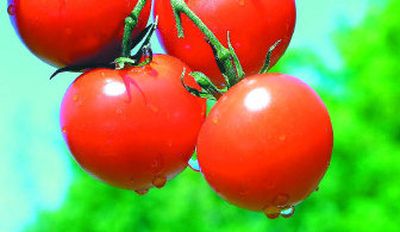Your best bet: short-season tomatoes

The tomato and pepper plants have been in the stores for weeks. When is it really time to plant them? Also I always have trouble getting them ripe at the end of the summer.
Ann, Coeur d’Alene
This is probably one of the most frequently asked questions by Inland Northwest gardeners. I think we are safe at this point to plant tomatoes, peppers, eggplant, beans, corn, cucumbers, melons and squash. All these vegetables, and a few others, need warm soil and no chance of frost. But it’s always a good idea to keep the sheets handy, especially if you live at higher elevations or in perennial cold pockets.
Getting tomatoes and peppers to ripen at the end of the summer takes some planning and preparation now. First, buy short-season varieties. This information should be on the tag. Tomatoes and peppers should have a 65-75 day ripening time. Many people like to grow heirloom tomatoes, and they are fine if we get a long hot growing season, but most of them take more than 75 days to ripen.
You can help them along though now by covering them with floating row cover. Water and light get through but the fabric holds in some of the heat, especially at night. The fabric can be removed in late June, when the nights begin to stay over 55 degrees. Both tomatoes and peppers need 55-degree nights to begin setting fruit.
At the end of the summer, after it cools off, reinstall the fabric to again hold heat in and help finish ripening.
Cursed with crabgrass
I have a major problem with crabgrass. How do I get rid of it?
Mark Turner
Crabgrass is an annual weedy grass that invades moist lawns and garden beds during warmer weather. It has large hairy leaves that grow out in a flat circle with branched seed heads that look like bird’s feet. Because it is an annual, the plant itself lives one year. It reproduces by growing great quantities of seed that overwinter in the soil. Controlling the seed production is the key to getting rid of crabgrass.
First make sure your lawn is healthy. Avoid watering lightly on a daily basis in favor of deep soakings every three to five days, depending on your soil. Fertilize properly so the grass grows in thickly. Reseed bare spots, as crabgrass will invade bare areas first. Mow at the proper height.
Because crabgrass is a grass, broadleaf herbicides won’t affect it. The best way to control it is to apply a pre-emergent herbicide to the lawn about the time the forsythias finish blooming in the spring. These are sold under a variety of trade names and are often combined with fertilizers. An organic control product is corn gluten meal. These herbicides prevent the seed from germinating and kill very young seedlings. The pre-emergent herbicide can also be applied to garden beds if crabgrass is a problem there. Later in the summer, keep an eye out for errant plants that are going to seed and pull them.